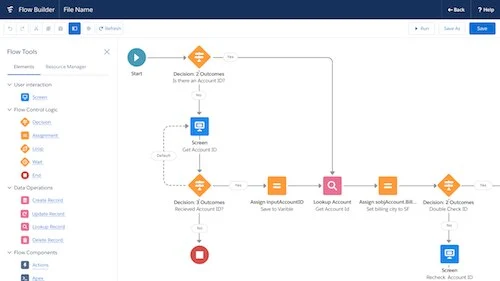In today’s fast-paced business landscape, providing exceptional customer service is no longer a luxury – it’s a necessity. That’s where Salesforce Service Cloud comes into play. This comprehensive platform empowers businesses to deliver top-notch customer support, enhance satisfaction levels, and build lasting relationships. In this article, we’ll take an in-depth look at Salesforce Service Cloud, its features, benefits, and how it can revolutionize your customer service strategies.

Salesforce Service Cloud: A 360-Degree View
Salesforce Service Cloud is a cutting-edge customer service solution that caters to businesses of all sizes. It offers a unified platform to manage customer interactions, resolve issues, and gain valuable insights for continuous improvement. With its user-friendly interface and robust capabilities, businesses can create seamless customer experiences while optimizing their support operations.
Key Features of Salesforce Service Cloud
- Omni-Channel Routing: Streamline customer inquiries across various communication channels, such as email, chat, social media, and phone calls. This ensures that customer interactions are efficiently distributed to the right agents, enhancing response times and customer satisfaction.
- Knowledge Base: Create a centralized repository of articles, FAQs, and solutions to common problems. This empowers customers to find answers on their own, reducing the load on support agents and providing quick resolutions.
- Case Management: Easily manage customer cases from initiation to resolution. Track progress, assign tasks, and collaborate with colleagues to ensure seamless issue resolution and customer delight.
- AI-Powered Insights: Leverage artificial intelligence to gain valuable insights from customer interactions. Understand trends, identify recurring issues, and proactively address concerns before they escalate.
- Self-Service Portals: Provide customers with personalized self-service portals where they can access their account information, track orders, and manage subscriptions. This fosters a sense of empowerment and convenience.
- Integration Capabilities: Integrate Salesforce Service Cloud with other business systems, such as CRM and marketing automation platforms. This enables a holistic view of customer interactions and facilitates data-driven decision-making.
Benefits of Implementing Salesforce Service Cloud
- Enhanced Customer Satisfaction: By providing prompt and accurate support, you can exceed customer expectations, leading to higher satisfaction levels and increased loyalty.
- Improved Efficiency: Automation and AI-driven insights help streamline support processes, enabling agents to focus on complex issues and providing faster resolutions to customers.
- Data-Driven Decision-Making: The platform offers robust reporting and analytics tools, allowing businesses to make informed decisions based on real-time data and trends.
- Personalized Interactions: With a comprehensive view of customer history and preferences, agents can offer personalized interactions that resonate with customers.
Getting Started with Salesforce Service Cloud
Implementing Salesforce Service Cloud into your business operations is a strategic decision that requires careful planning and execution. Here’s a step-by-step guide to help you get started:
Step 1: Needs Assessment
Identify your specific customer service pain points and objectives. Determine how Salesforce Service Cloud can address these challenges and align with your business goals.
Step 2: Customization
Tailor Salesforce Service Cloud to match your brand’s identity and requirements. Configure workflows, case categories, and automation rules to optimize the platform for your unique needs.
Step 3: Data Migration
Migrate existing customer data and case history seamlessly into the platform. Ensure data accuracy and consistency during the transfer process.
Step 4: Agent Training
Provide comprehensive training to your support agents on how to effectively use Salesforce Service Cloud. Highlight key features, best practices, and how to provide exceptional customer experiences.
Step 5: Launch and Monitoring
Launch Salesforce Service Cloud and closely monitor its performance. Collect feedback from customers and agents to identify areas for improvement and further optimization.
FAQs about Salesforce Service Cloud
- How does Salesforce Service Cloud improve customer engagement? Salesforce Service Cloud offers omni-channel support, allowing customers to reach out via their preferred communication channels. This enhances engagement by providing convenience and accessibility.
- Can Salesforce Service Cloud integrate with third-party applications? Yes, the platform offers robust integration capabilities. It can seamlessly integrate with various third-party applications, enhancing data accuracy and streamlining processes.
- Is AI used only for data analysis, or does it play a role in customer interactions? AI in Salesforce Service Cloud goes beyond data analysis. It powers chatbots and virtual assistants that can handle routine inquiries, freeing up agents for more complex tasks.
- What benefits can businesses expect from using the knowledge base feature? The knowledge base feature reduces the load on support agents by empowering customers to find answers independently. This leads to faster issue resolution and improved customer satisfaction.
- Is Salesforce Service Cloud suitable for small businesses? Absolutely. Salesforce Service Cloud offers scalable solutions suitable for businesses of all sizes. Small businesses can enjoy the same level of support and efficiency as larger enterprises.
- How does Salesforce Service Cloud contribute to data security? The platform employs robust security measures to protect customer data. It offers features like role-based access control and data encryption to ensure data security and compliance.
In a competitive business landscape, exceptional customer service can set your brand apart. Salesforce Service Cloud equips businesses with the tools they need to deliver top-tier support, enhance customer satisfaction, and drive growth. By leveraging its powerful features and insights, you can create memorable customer experiences and build lasting relationships.




